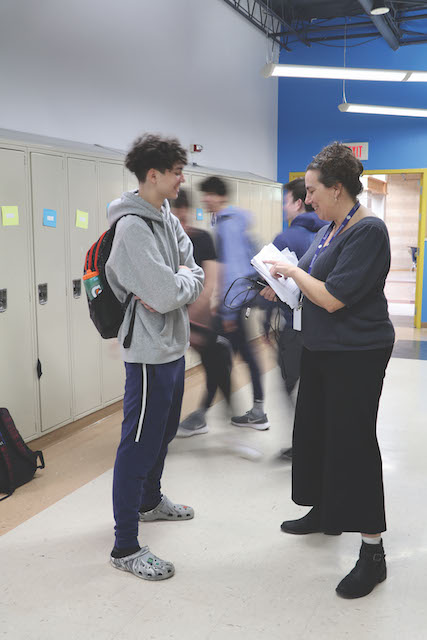Less is more
Netanya Shaffin, Dimensions Yearbook
Small class size gives private school students an academic edge.
March 18, 2023
The national average class size for public schools is 24 students. The average class sizes for Walter Johnson High School and Sherwood High School, two local public high schools, are 26 and 21 students respectively (2019-2020). Yet, the average class size at CESJDS is 13 students. What are the implications of this variation, and how does class size positively or negatively impact students?
Significance of Class Size
Studies surrounding ideal class size have circulated for years, coming to various conclusions. However, the general consensus is that smaller classes pose many benefits. According to eSchoolNews, some of these include improved teacher-student relationships, more customized instruction, collaboration in the classroom and teacher retention.
These first two advantages draw from the teachers’ ability to provide more individualized attention. When teachers have time to address each student individually, they are able to build stronger relationships with their students. Additionally, with fewer students, teachers have more time outside of class to offer help, thus improving these connections. Teachers can gain a better understanding of the teaching methods and speed of instruction that fits their students’ needs.
Sophomore Mia Endelman, who has been home-schooled, attended public school and is a current JDS student, attests to the advantages of small class sizes and improved teacher relationships.
“You definitely learn better with small classes…because the teacher can pay individual attention to you,” Endelman said. “In a class of 30 people, you’re either moving too fast or too slow.”
Howard Community College English professor Helen Clark, and former English staff support at Rockville High School, has seen first-hand how difficult it is for educators to connect with students and determine what they are struggling with in such a large classroom setting.
“I definitely believe very strongly that the relationship between teacher and students is really vital to students’ engagement,” Clark said. “When you have a really big classroom, really experienced teachers that are like super wizards can zero in on some [struggles], but it’s just a lot harder because you have so much going on, so much content that you need to teach and so many papers to grade.”
Smaller classes not only impact the relationship teachers have with their students, but they also impact the relationship students have with one another. eSchoolNews explains that increased collaboration in the classroom emerges when students are more comfortable interacting with each other.
“It’s easier if you’re friends with everyone in the classroom, and you’re having a class discussion, it’s easier to open up and talk,” Endelman said. “Not so much in a big class where you know half the people, but not the other half, so you get nervous with the other half.”
Aside from student experience, it is also important to note that 10% of teachers cite class size as their reasoning for leaving either their schools or profession entirely, according to eSchoolNews.
According to Academic Dean Aileen Goldstein, JDS is aware of the research regarding class size and takes this into account when building schedules. JDS classes are capped at 18 students. Any classes that surpass the limit require permission from the principal. The largest class this year, a section of World History I, has 21 students. In contrast, Montgomery County Public School classes cut off at 29 students for English classes and 32 students for all other classes.
“One of our goals as an independent school is to really provide as much individualized attention as we can in order to invest in meeting the individual needs of each student,” Goldstein said. “The smaller the class and the better the student-teacher ratio, the more you can give attention to each individual student and their needs at the same time.”
However, the school also recognizes the disadvantages of having a class be too small. The smallest class running this year is two students.
“We also are looking for critical mass, because we have put tremendous value in the group experience and in the rich conversation that comes when you have a critical mass in the classroom together,” Goldstein said. “Because of our emphasis on pluralism and our emphasis on critical thinking and processing, you really need to hear a multitude of perspectives, and so there’s that sort of a healthy balance in between.”
Class Size and College Admissions
Smaller class sizes enable students to receive their education in a more intimate learning environment, which provides many benefits to the college process.
JDS provides its students with a bounty of resources for college preparation through its college guidance department. However, another element of JDS education that prepares students for the college process is classroom engagement.
Director of College Guidance Sue Rexford explained that classroom dynamics can help students prepare for both standardized tests and written applications, in a way that external help cannot.
“… [What I think] JDS does really well, by the way, is critical analysis, critical thinking, close reading skills: the types of things that you do in many of your classes and you don’t even realize what a difference that’s going to make when you sit down to take a standardized test,” Rexford said.
With Rexford’s point of the JDS classroom preparing students for the college process in mind, the quality of the content is not the same when class sizes are larger. As part of the process of earning her Masters Degree, Sarah Leahy of Marygrove College surveyed a group of teachers about their opinions on the impact of smaller classes on students’ quality of learning. In the survey, the consensus was that smaller class sizes allow teachers to spend more time focusing on “the curriculum being taught instead of discipline and other issues that are occurring around them.”
Not only are students in smaller classroom environments able to go more in-depth with their classroom time, but they are also able to receive more individual help from their teachers. This specialized instruction also helps with standardized testing and the overall college process.
Because of the individual relationships between students and teachers, students are able to use these connections when requesting recommendation letters, which gives students in smaller classes a very large advantage when it comes to the college process.
“Students who come to you and want [a recommendation letter] because you offer them a safe space, something that they’ve needed, whether it’s academically or emotionally, you have the rapport with them,” history and psychology teacher Matt Cohen said. “ … I feel honored by that process, to have kids come to me and say ‘will you write this recommendation for me,’ and it really does a nice job of culminating [the] relationship.”
Teacher Relationships
Friendly conversations between students and faculty often fill the JDS hallways, the sort of small talk that enhances their relationships. This dynamic that is characteristic of JDS enhances the learning experience for teachers and students alike.
Cohen taught for four years at a public school in Chicago before coming to JDS. That background helps him appreciate the ease that comes with smaller class sizes at JDS. He believes that a smaller class helps both the student and teacher succeed, and allows for better connections in the classroom.
“It’s tougher when you have so many kids that you are trying to serve, and usually in public school there are a lot of kids way across the learning spectrum,” Cohen said. “Sometimes it can be tough to be able to meet all of those kids’ [needs].”
On top of the more visible differences between public and private school classes, Cohen also explained that smaller class sizes allow him to explore a variety of teaching styles and delve deeper into students’ interests.
Cohen was able to foster more quality relationships with his students when he had fewer students to teach at one time. Junior Sofia Guerson, who just switched to JDS from public school this year, agrees with this sentiment.
“I have a much closer relationship with my teachers and my other classmates,” Guerson said. “At JDS, there’s a lot more guidance, and there’s more support, so it’s more nurturing.”
At Walt Whitman High School, her previous school, she felt like there was little to no support from her teachers. By having the perspective of being at both a public and smaller private school, she said it was likely that her teachers had to sacrifice student relationships to manage the larger workload that came with teaching three or four times the students as the average teacher at JDS.
“[The teachers] just don’t have time for you because they have probably hundreds of students,” Guerson said. “If I wanted to go and ask them a question about something, they [would] usually try to answer it as fast as possible so they can get to the next thing. So, I had to figure things out by myself a lot.”
Finding a Solution
Despite all of the detrimental effects of a large class size, widespread class size reduction in public schools is not a simple feat. According to the Brown Center on Education Policy at Brookings, even decreasing the present average class size by just one student would cost the U.S. billions of dollars.
Teacher salaries account for a large element of that cost. There are approximately 3.2 million teachers serving 49.3 million students in public schools, corresponding to 15.3 students per teacher. Decreasing that ratio to 14.3 would require hiring 226,000 additional teachers. At an average teacher salary of $55,000, that would cost the US $12.4 billion a year, merely in salary costs. While the Brown Center on Education Policy at the Brookings Institution released these numbers in 2011, the data is similar in 2023.
Adding more classes would generate a need for more classrooms, as well. For a decrease of average class size by one student, 225,000 classrooms would need to be added.
Clearly, an instant decrease in class size is unattainable, but the status quo has also proven problematic. As such, communities across the country are looking for solutions.
One such solution is a bill Maryland Senator Pamela Beidle is currently sponsoring. Maryland teachers want to include class size in contract negotiations with local boards of education, which is not currently permitted in Maryland. Beidle’s bill would give teachers that negotiation power.
Because class size is not a problem for JDS, teachers do not need to focus their energy on education reform and negotiations. That means that they can focus more on what really matters in a classroom: the students.
Teachers and students across the JDS community have attested to the difference a smaller class makes, and have expressed appreciation at the emphasis the school puts on creating these spaces.
Coming from a place of such academic privilege, it is important that members of the JDS community join the fight against overcrowded classrooms in local public schools. Consider raising awareness and advocating for legislation like Beidle’s bill, lobbying for more funding from state and local representatives, donating to local public school’s fundraising efforts, such as mulch and book sales.
JDS students are incredibly fortunate to have access to the resources and smaller class sizes that the school offers. When offered such significant supports, students should recognize and appreciate these advantages, and work to ensure others are given similar opportunities.











